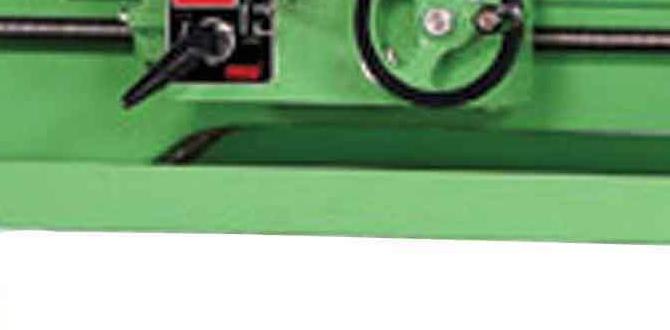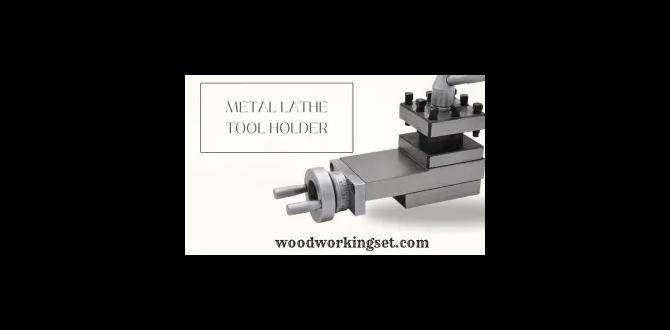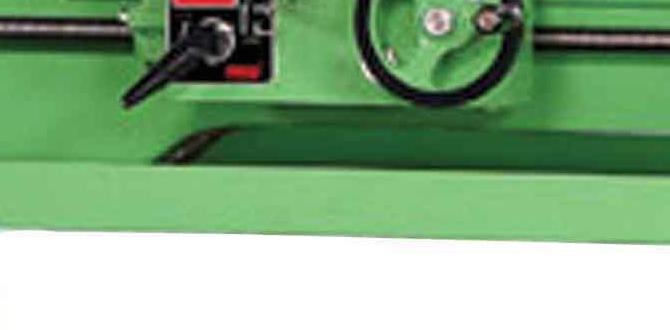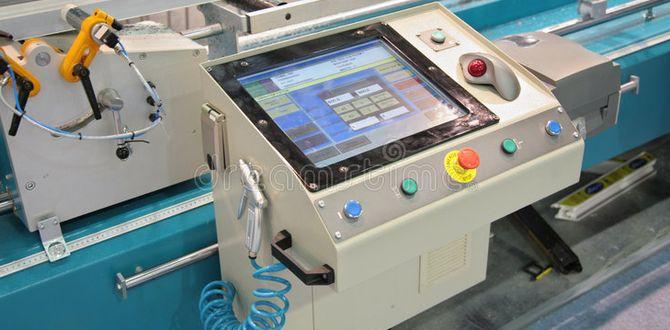Stop wood lathe vibration dead in its tracks with these proven fixes. Learn to balance your workpiece, level your machine, and use dampening techniques for smoother, safer turning and better results.
It’s a familiar problem for woodturners: the dreaded lathe vibration. That shaking and shuddering can turn a relaxing turning session into a frustrating battle, compromising safety and the quality of your workpiece. But don’t worry! You’re not alone, and thankfully, there are straightforward solutions that can get your lathe running smooth as silk. In this guide, we’ll walk through simple, effective methods to diagnose and eliminate wood lathe vibration, so you can get back to enjoying the art of turning.
Understanding Wood Lathe Vibration: What’s Causing It?
Before we can fix it, we need to understand why that vibration is happening. Most wood lathe vibration stems from a few key culprits. Think of it like a wobbly wheel on a bicycle – something is out of balance or alignment. For beginners, identifying these issues is the first step to a stable and enjoyable turning experience.
The Workpiece: The Most Common Culprit
The most frequent cause of vibration is an unbalanced workpiece. When you mount a piece of wood, especially one that’s irregularly shaped, has knots, or is significantly off-center, it creates an imbalance. As the lathe spins, this uneven mass is flung outwards, causing the shudder.
- Irregular Shapes: A freshly cut log or a blob of wood that isn’t yet round will inherently be unbalanced.
- Knots and Inclusions: Dense knots or voids within the wood can create pockets of different weight, throwing off the balance.
- Off-Center Mounting: If your workpiece isn’t properly centered on the headstock and tailstock when you start, it will vibrate severely.
The Lathe Itself: Stability and Alignment
Sometimes, the problem isn’t just the wood; it’s the machine. A lathe that isn’t securely placed or is inherently unstable will amplify any slight imbalance from the workpiece.
- Unstable Base: A lightweight stand or legs that aren’t sturdy can contribute significantly to vibration.
- Worn Bearings: The bearings in the headstock and tailstock are crucial for smooth rotation. Worn or damaged bearings can cause a distinct rumbling or knocking.
- Bent Spindle or Center: If the headstock spindle or a drive/live center is bent, it will create an eccentric rotation, leading to vibration.
- Loose Components: Any part of the lathe that isn’t tightened down – tool rest, tailstock, headstock cone – can vibrate and contribute to the overall shaking.
Tooling and Technique
Even with a balanced workpiece and a stable lathe, your tools and how you use them can introduce vibration.
- Dull Tools: Dull cutting edges don’t cut; they tear. This ragged action requires more force and can easily induce chatter and vibration.
- Improper Tool Rest Position: If the tool rest is too far from the workpiece or at the wrong angle, it doesn’t provide adequate support, leading to vibration.
- Applying Too Much Force: Pushing too hard or too quickly, especially when roughing out an uneven blank, will cause the lathe to fight back with vibration.
Proven Solutions for Wood Lathe Vibration
Now that we know what causes the wobble, let’s dive into the fixes. We’ll start with the easiest and most common, and then move to more in-depth checks.
1. Balance That Blank! (The Workpiece is King)
This is where you’ll find the biggest improvements, especially for beginners. A well-balanced blank makes a world of difference.
Roughing Out for Balance
When you first mount a piece of irregular wood, your goal is to quickly round it. This is often the most viberation-prone stage.
- Secure Mounting: Ensure your wood is firmly gripped by the drive center and held by the tailstock.
- Start Slow: Begin at the lowest speed setting your lathe offers. This minimizes the forces of imbalance.
- Gentle Cuts: Use a roughing gouge and take light, controlled cuts. Don’t try to hog off large amounts of wood at once.
- Work Inward: Gradually turn the blank round, working from the center towards the ends.
- Gradual Speed Increase: As the blank becomes more round, you can slowly increase the lathe’s speed. Listen and feel for an increase in vibration. If it gets bad, decrease the speed.
A good rule of thumb from experienced turners is to aim for a wood blank that has a reasonably consistent diameter around its circumference. If one part is significantly thicker than another, it will cause major imbalance. You can even use a compass or a piece of string to mark lines around the blank, indicating the desired final diameter, and aim to turn down to these lines evenly.
Using a Faceplate or Chuck for Irregular Shapes
For very large or oddly shaped pieces, a faceplate or chuck can offer more secure mounting and better balance. When using a faceplate, ensure the wood is well-screwed to it, and when using a chuck, make sure the jaws grip the wood as evenly as possible.
2. Level and Secure Your Lathe
A wobbly lathe is an amplifier for minor imbalances. Making sure your machine is stable is critical.
Check the Lathe’s Feet
Most lathes come with feet that sit on the floor, or they might be mounted on a stand. If your lathe has adjustable feet, use them to ensure all points of contact are firm on the floor. If it’s on a stand, ensure the stand itself is robust and not wobbling.
For older lathes or those with very basic stands, you might consider aftermarket solutions. Companies like Rockler or Woodcraft offer robust lathe stands and wheel kits that can significantly improve stability. Even simple, heavy-duty casters can be bolted to the lathe’s base to make it mobile while still providing a solid foundation.
The Importance of a Solid Floor
Even a perfectly leveled lathe can vibrate if the floor it’s on is bouncy. Concrete floors offer the best stability. If you’re on a wooden floor, try to ensure the lathe is positioned over joists, or consider reinforcing the floor area where the lathe sits.
Securing the Lathe (Optional but Recommended for Heavy Duty Work)
For larger lathes or if you’re experiencing persistent vibration, you might consider bolting the lathe down to a sturdy workbench or a dedicated cabinet base. Use heavy-duty lag bolts or mounting hardware. This is especially useful if your lathe is on casters; ensure the casters have locking mechanisms.
3. Dampening the Vibration
Once the primary issues of workpiece balance and lathe stability are addressed, you can use dampening materials to absorb residual vibrations.
Anti-Vibration Pads
These are specifically designed mats or pads made from dense rubber or composite materials. You place them directly under the lathe’s feet or stand. They work by absorbing and dissipating the vibrations before they can transfer to the floor or the lathe itself.
When selecting anti-vibration pads, look for ones rated for heavy machinery. A common recommendation for wood lathes is to use pads designed for washing machines; their dense, shock-absorbing rubber is effective. Ensure the pads are thick enough to offer substantial cushioning. They can be found at hardware stores, home improvement centers, or specialized woodworking suppliers.
Benefits of Anti-Vibration Pads:
- Reduces noise transmission to other parts of the house or workshop.
- Protects your floor from scratches and impacts.
- Can further stabilize an already securely placed machine.
DIY Dampening Solutions
- Heavy Rubber Mats: Old tire mats or thick, dense rubber mats can be cut to size and placed under the lathe.
- Sandbags or Weights: For extremely lightweight lathes, strategically placed sandbags or concrete blocks on the lathe’s base (if it’s designed to hold them) can add mass and stability. Be careful not to interfere with any moving parts or controls.
4. Check and Maintain Your Lathe Components
Now let’s get into the mechanical aspects of the lathe itself.
Headstock and Tailstock Bearings
These are the heart of your lathe’s smooth operation. They need to be in good condition.
- Listen: As the lathe spins (with no wood mounted), listen for any grinding, rumbling, or clicking sounds. These can indicate worn bearings.
- Feel: Gently try to rock the headstock cone. There should be very little play.
- Lubrication: Follow your lathe’s manual for recommended lubrication points. Proper lubrication reduces friction, wear, and noise.
- Replacement: If you suspect worn bearings, consult your lathe’s manual for the part number and consider ordering replacements. This is a more advanced repair, but can make a huge difference. For many common benchtop lathes, bearing kits are readily available from the manufacturer or specialized parts suppliers. For instance, if you have a popular brand like a Shop Fox or Grizzly, you can often find diagrams and part numbers on their websites.
Drive Centers and Live Centers
These components transfer power from the headstock to the workpiece and support it at the tailstock. They must be straight.
- Visual Inspection: Look closely for any visible bends or damage on the drive or live center.
- Spin Test: Mount a center (without wood) and run the lathe at a very slow speed. Watch the tip of the center. If it wobbles noticeably, it’s likely bent.
- Straightening or Replacement: Minor bends might be fixable with careful straightening, but replacement is often the best and safest option. A bent center will cause significant and persistent vibration. You can find replacement centers that are specifically designed for wood lathes from woodworking tool retailers like https://www.rockler.com/.
Tool Rest and Tailstock Clamping
These parts need to be securely locked down.
- Tool Rest: Position the tool rest as close to the workpiece as possible without touching it. Ensure the tool rest locking handle is fully tightened. A loose tool rest will vibrate against the spinning wood, creating chattering.
- Tailstock: Make sure the tailstock is locked securely to the lathe bed and that the live center (if used) is firmly in place. Any looseness here will translate directly into vibration, especially when turning longer pieces.
5. Sharpen Your Turning Tools
This is a maintenance task that has a huge impact on vibration and the finish of your work. Dull tools are the enemy of smooth turning.
Dull tools don’t cut cleanly; they compress and tear the wood fibers. This ragged engagement requires more force and leads to chatter marks on the wood’s surface, which are a direct result of vibration. Keep your:
- Gouges: Sharpen them to a clean, defined edge.
- Scrapers: Ensure they are properly burnished and have a sharp burr if appropriate for the task.
- Skew Chisels: A sharp edge is paramount for smooth shearing cuts.
Regular sharpening, using sharpening jigs, grinding wheels, or diamond stones, will make your tools cut like butter, reducing the forces that cause vibration.
6. Review Your Turning Technique
Sometimes, technique is the missing piece of the puzzle.
Tool Pressure and Angle
Don’t force the cut. Let the tool do the work. Apply steady, even pressure. For roughing, use sweeping cuts with your gouge. For shaping, understand the proper angles to engage the wood for a clean shear or scraping cut. For instance, when using a skew for finishing, engaging the wood with the “cutting edge” side of the skew is crucial for a smooth, vibration-free surface. Incorrect angles can cause snagging and vibration.
Depth of Cut
When roughing out a blank or turning a challenging piece, take lighter, more numerous cuts rather than one aggressive pass. This allows the lathe and the wood to stabilize between cuts and reduces the stress that can cause vibration.
Working with the Grain
Always aim to cut “downhill” with the grain whenever possible. Cutting “uphill” against the grain is more likely to cause tear-out and vibration. This is particularly important when turning end grain or working with figured woods.
7. Balancing the Lathe Chuck or Faceplate
If you primarily use a chuck or faceplate and notice vibration even with a reasonably balanced workpiece, the chuck/faceplate itself might be slightly unbalanced due to its construction or how accessories are attached.
- Chuck Jaws: Ensure all chuck jaws are of the same brand and type, and that they are correctly seated. Some chuck manufacturers offer balancing kits.
- Faceplate Accessories: If you’ve attached additional hardware to a faceplate, ensure it’s symmetrically mounted.
For most beginner wood lathe setups, this is less of a concern than the workpiece or the lathe’s stability, but it’s worth considering if you’ve exhausted other troubleshooting steps.
Troubleshooting Table
Here’s a quick reference table to help you diagnose vibration issues:
| Symptom | Likely Cause | Primary Solution | Secondary Solution(s) |
|---|---|---|---|
| Severe vibration when starting to turn a new blank. | Unbalanced workpiece (irregular shape, off-center). | Rough out the workpiece to a round shape at low speed. | Ensure drive/live centers are properly engaged. |
| Consistent, low-frequency wobble even with a round piece. | Lathe not level or unstable base. | Level the lathe and ensure legs are firmly on the ground. | Use anti-vibration pads, secure lathe to floor/workbench. |
| Grinding or rumbling noise and vibration, especially at higher speeds. | Worn headstock or tailstock bearings. | Inspect and lubricate bearings. Consider replacement if worn. | Check drive/live center for straightness; ensure tailstock is locked. |
| Chatter marks on the surface with a seemingly balanced piece. | Dull tools, improper tool angle, or tool rest too far away. | Sharpen tools and adjust tool rest closer to workpiece. | Refine cutting technique, use lighter cuts. |
| Vibration that seems to come from the tailstock end. | Loose tailstock clamp or bent live center. | Ensure tailstock is securely locked and live center is straight. | Check for play in the tailstock quill. |
Maintaining a Vibration-Free Wood Lathe
Prevention is just as important as cure when it comes to vibration. A little regular maintenance goes a long way.
- Regular Tool Sharpening: Make it a habit to sharpen your tools before each turning session or as needed.
- Inspect Centers and Drive: Periodically check your drive and live centers for bends or damage.
- Tighten Everything: Before you start turning, give a quick check to ensure all clamps and locking mechanisms are tight.
- Clean Your Lathe: Dust and chips can interfere with moving parts and locking systems. Keep your lathe clean.
- Listen to Your Lathe: Pay attention to any new sounds or changes in how your lathe operates. Early detection of issues can prevent major problems.
A well-maintained lathe is a safe lathe. Following these simple checks and maintenance routines will ensure your machine performs reliably and minimizes the risk of vibration-related issues. Learning about your lathe’s maintenance schedule can be found in various online resources. For instance, many manufacturers provide downloadable PDFs for their models on their official websites, offering detailed care instructions. For a deeper understanding of preventative maintenance for woodworking tools, you can refer to guides from organizations like the International School of Woodworking Arts (though this specific link might be a placeholder, look for similar woodworking safety and maintenance organizations).
Frequently Asked Questions (FAQ)
Q1: What’s the first thing I should do if my wood lathe starts vibrating violently?
A1: Immediately stop the lathe. The most common cause is an unbalanced workpiece. If you’ve just mounted a new piece, it’s likely the culprit. Assess its roundness and how securely it’s mounted before restarting, preferably at a very low speed.
Q2: Can a cheap wood lathe cause more vibration than an expensive one?
A2: Not necessarily. While higher-end lathes often have better-engineered components for stability, a beginner can experience vibration on






